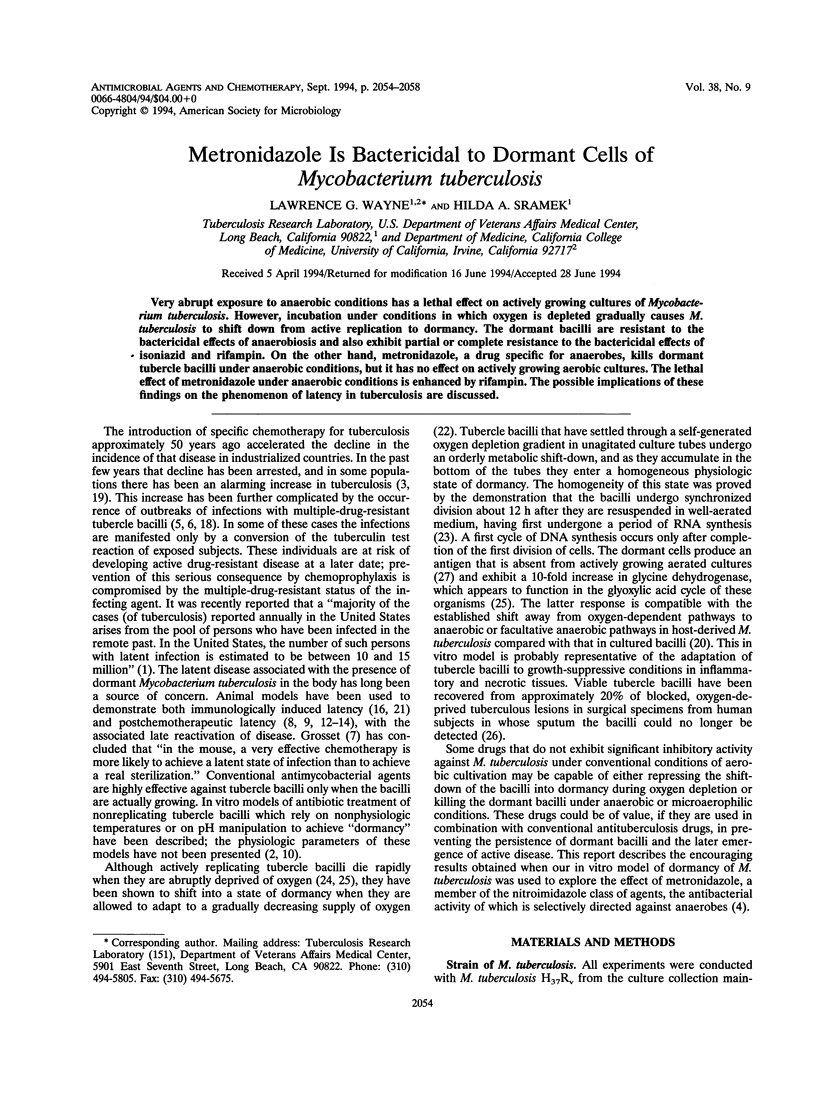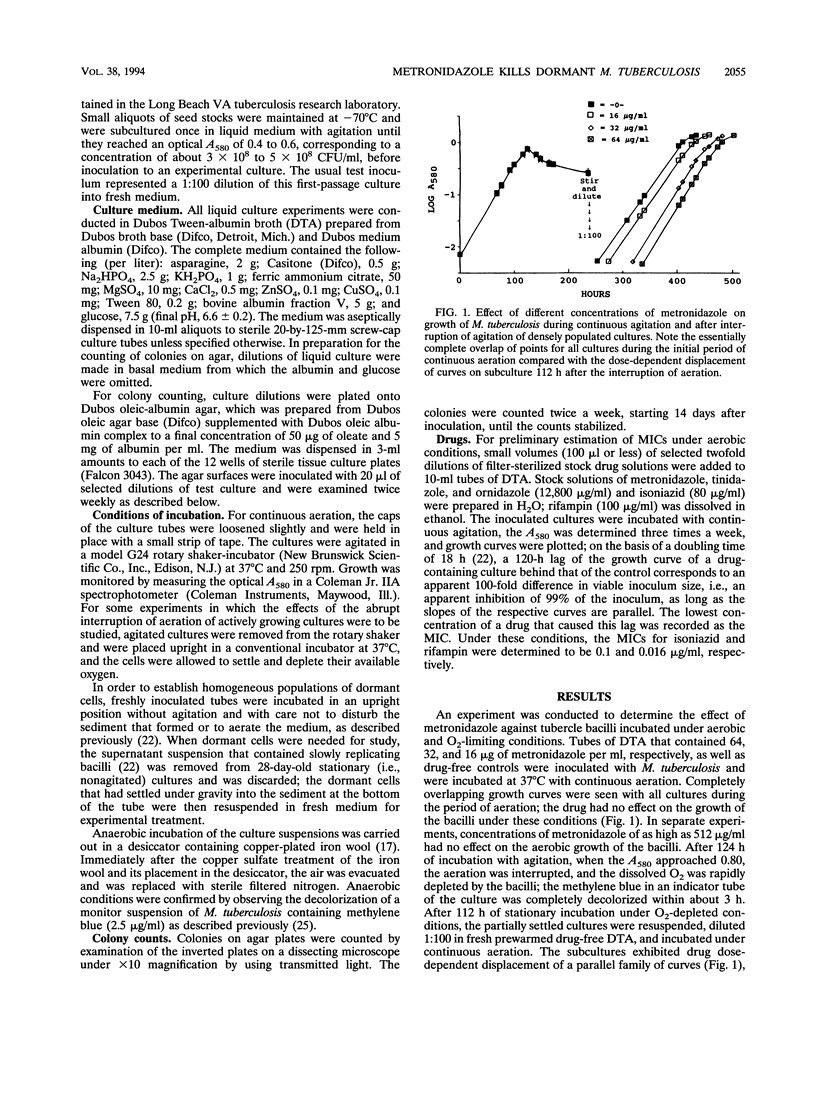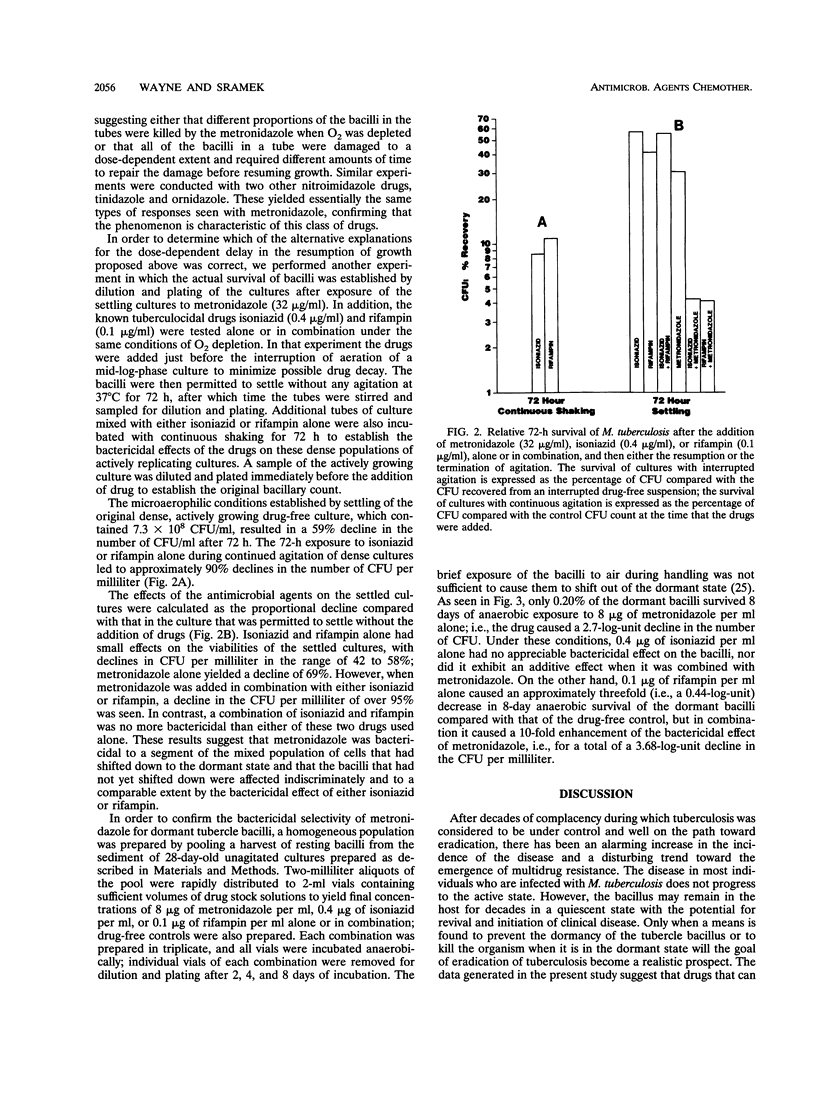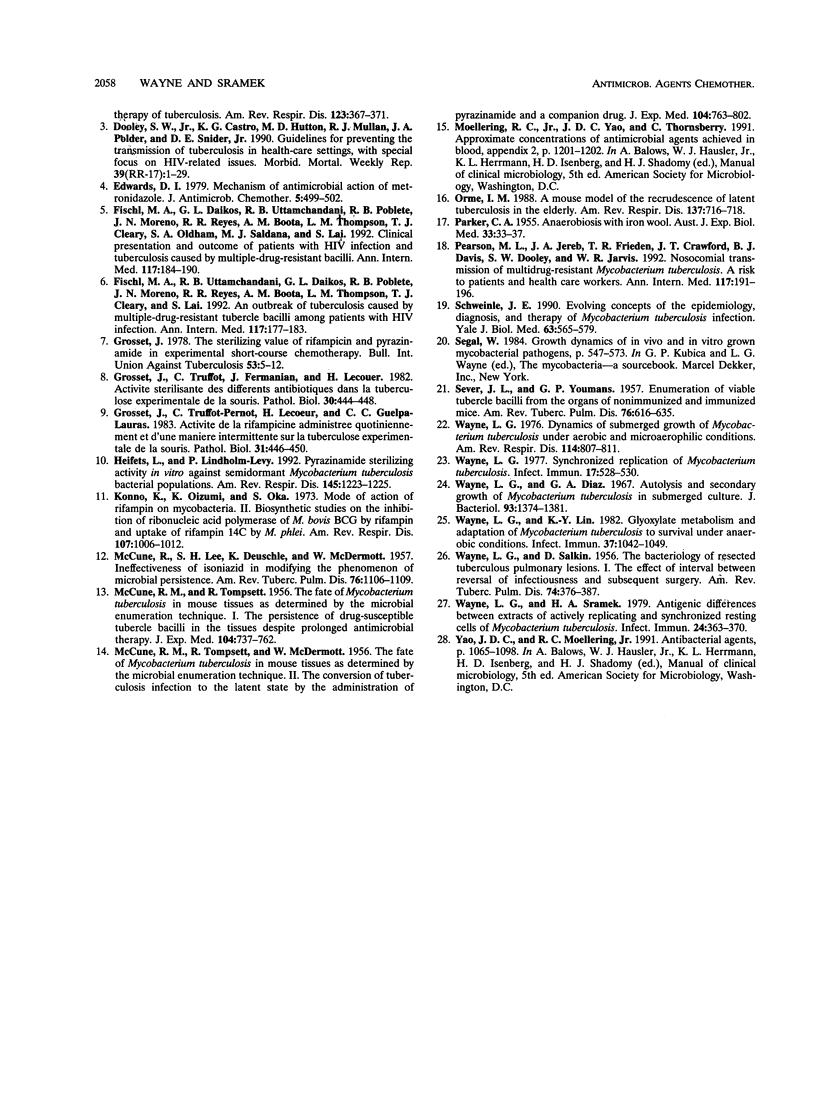Abstract
Very abrupt exposure to anaerobic conditions has a lethal effect on actively growing cultures of Mycobacterium tuberculosis. However, incubation under conditions in which oxygen is depleted gradually causes M. tuberculosis to shift down from active replication to dormancy. The dormant bacilli are resistant to the bactericidal effects of anaerobiosis and also exhibit partial or complete resistance to the bactericidal effects of isoniazid and rifampin. On the other hand, metronidazole, a drug specific for anaerobes, kills dormant tubercle bacilli under anaerobic conditions, but it has no effect on actively growing aerobic cultures. The lethal effect of metronidazole under anaerobic conditions is enhanced by rifampin. The possible implications of these findings on the phenomenon of latency in tuberculosis are discussed.
Full text
PDF




Selected References
These references are in PubMed. This may not be the complete list of references from this article.
- Dickinson J. M., Mitchison D. A. Experimental models to explain the high sterilizing activity of rifampin in the chemotherapy of tuberculosis. Am Rev Respir Dis. 1981 Apr;123(4 Pt 1):367–371. doi: 10.1164/arrd.1981.123.4.367. [DOI] [PubMed] [Google Scholar]
- Dooley S. W., Jr, Castro K. G., Hutton M. D., Mullan R. J., Polder J. A., Snider D. E., Jr Guidelines for preventing the transmission of tuberculosis in health-care settings, with special focus on HIV-related issues. MMWR Recomm Rep. 1990 Dec 7;39(RR-17):1–29. [PubMed] [Google Scholar]
- Edwards D. I. Mechanism of antimicrobial action of metronidazole. J Antimicrob Chemother. 1979 Sep;5(5):499–502. doi: 10.1093/jac/5.5.499. [DOI] [PubMed] [Google Scholar]
- Fischl M. A., Daikos G. L., Uttamchandani R. B., Poblete R. B., Moreno J. N., Reyes R. R., Boota A. M., Thompson L. M., Cleary T. J., Oldham S. A. Clinical presentation and outcome of patients with HIV infection and tuberculosis caused by multiple-drug-resistant bacilli. Ann Intern Med. 1992 Aug 1;117(3):184–190. doi: 10.7326/0003-4819-117-3-184. [DOI] [PubMed] [Google Scholar]
- Fischl M. A., Uttamchandani R. B., Daikos G. L., Poblete R. B., Moreno J. N., Reyes R. R., Boota A. M., Thompson L. M., Cleary T. J., Lai S. An outbreak of tuberculosis caused by multiple-drug-resistant tubercle bacilli among patients with HIV infection. Ann Intern Med. 1992 Aug 1;117(3):177–183. doi: 10.7326/0003-4819-117-3-177. [DOI] [PubMed] [Google Scholar]
- Grosset J. The sterilizing value of rifampicin and pyrazinamide in experimental short-course chemotherapy. Bull Int Union Tuberc. 1978 Mar;53(1):5–12. [PubMed] [Google Scholar]
- Grosset J., Truffot-Pernot C., Lecoeur H., Guelpa-Lauras C. C. Activité de la rifampicine administrée quotidiennement et d'une manière intermittente sur la tuberculose expérimentale de la souris. Pathol Biol (Paris) 1983 May;31(5):446–450. [PubMed] [Google Scholar]
- Grosset J., Truffot C., Fermanian J., Lecoeur H. Activité stérilisante des différents antibiotiques dans la tuberculose expérimentale de la souris. Pathol Biol (Paris) 1982 Jun;30(6):444–448. [PubMed] [Google Scholar]
- Heifets L., Lindholm-Levy P. Pyrazinamide sterilizing activity in vitro against semidormant Mycobacterium tuberculosis bacterial populations. Am Rev Respir Dis. 1992 May;145(5):1223–1225. doi: 10.1164/ajrccm/145.5.1223. [DOI] [PubMed] [Google Scholar]
- Konno K., Oizumi K., Oka S. Mode of action of rifampin on mycobacteria. II. Biosynthetic studies on the inhibition of ribonucleic acid polymerase of Mycobacterium bovis BCG by rifampin and uptake of rifampin- 14 C by Mycobacterium phlei. Am Rev Respir Dis. 1973 Jun;107(6):1006–1012. doi: 10.1164/arrd.1973.107.6.1006. [DOI] [PubMed] [Google Scholar]
- MCCUNE R. M., Jr, MCDERMOTT W., TOMPSETT R. The fate of Mycobacterium tuberculosis in mouse tissues as determined by the microbial enumeration technique. II. The conversion of tuberculous infection to the latent state by the administration of pyrazinamide and a companion drug. J Exp Med. 1956 Nov 1;104(5):763–802. doi: 10.1084/jem.104.5.763. [DOI] [PMC free article] [PubMed] [Google Scholar]
- MCCUNE R. M., Jr, TOMPSETT R. Fate of Mycobacterium tuberculosis in mouse tissues as determined by the microbial enumeration technique. I. The persistence of drug-susceptible tubercle bacilli in the tissues despite prolonged antimicrobial therapy. J Exp Med. 1956 Nov 1;104(5):737–762. doi: 10.1084/jem.104.5.737. [DOI] [PMC free article] [PubMed] [Google Scholar]
- McCUNE R., LEE S. H., DEUSCHLE K., McDERMOTT W. Ineffectiveness of isoniazid in modifying the phenomenon of microbial persistence. Am Rev Tuberc. 1957 Dec;76(6):1106–1109. doi: 10.1164/artpd.1957.76.6.1106. [DOI] [PubMed] [Google Scholar]
- Orme I. M. A mouse model of the recrudescence of latent tuberculosis in the elderly. Am Rev Respir Dis. 1988 Mar;137(3):716–718. doi: 10.1164/ajrccm/137.3.716. [DOI] [PubMed] [Google Scholar]
- PARKER C. A. Anaerobiosis with iron wool. Aust J Exp Biol Med Sci. 1955 Feb;33(1):33–37. doi: 10.1038/icb.1955.4. [DOI] [PubMed] [Google Scholar]
- Pearson M. L., Jereb J. A., Frieden T. R., Crawford J. T., Davis B. J., Dooley S. W., Jarvis W. R. Nosocomial transmission of multidrug-resistant Mycobacterium tuberculosis. A risk to patients and health care workers. Ann Intern Med. 1992 Aug 1;117(3):191–196. doi: 10.7326/0003-4819-117-3-191. [DOI] [PubMed] [Google Scholar]
- SALKIN D., WAYNE L. G. The bacteriology of resected tuberculous pulmonary lesions. I. The effect of interval between reversal of infectiousness and subsequent surgery. Am Rev Tuberc. 1956 Sep;74(3):376–387. doi: 10.1164/artpd.1956.74.3.376. [DOI] [PubMed] [Google Scholar]
- SEVER J. L., YOUMANS G. P. Enumeration of viable tubercle bacilli from the organs of nonimmunized and immunized mice. Am Rev Tuberc. 1957 Oct;76(4):616–635. doi: 10.1164/artpd.1957.76.4.616. [DOI] [PubMed] [Google Scholar]
- Schweinle J. E. Evolving concepts of the epidemiology, diagnosis, and therapy of Mycobacterium tuberculosis infection. Yale J Biol Med. 1990 Nov-Dec;63(6):565–579. [PMC free article] [PubMed] [Google Scholar]
- Wayne L. G., Diaz G. A. Autolysis and secondary growth of Mycobacterium tuberculosis in submerged culture. J Bacteriol. 1967 Apr;93(4):1374–1381. doi: 10.1128/jb.93.4.1374-1381.1967. [DOI] [PMC free article] [PubMed] [Google Scholar]
- Wayne L. G. Dynamics of submerged growth of Mycobacterium tuberculosis under aerobic and microaerophilic conditions. Am Rev Respir Dis. 1976 Oct;114(4):807–811. doi: 10.1164/arrd.1976.114.4.807. [DOI] [PubMed] [Google Scholar]
- Wayne L. G., Lin K. Y. Glyoxylate metabolism and adaptation of Mycobacterium tuberculosis to survival under anaerobic conditions. Infect Immun. 1982 Sep;37(3):1042–1049. doi: 10.1128/iai.37.3.1042-1049.1982. [DOI] [PMC free article] [PubMed] [Google Scholar]
- Wayne L. G., Sramek H. A. Antigenic differences between extracts of actively replicating and synchronized resting cells of Mycobacterium tuberculosis. Infect Immun. 1979 May;24(2):363–370. doi: 10.1128/iai.24.2.363-370.1979. [DOI] [PMC free article] [PubMed] [Google Scholar]
- Wayne L. G. Synchronized replication of Mycobacterium tuberculosis. Infect Immun. 1977 Sep;17(3):528–530. doi: 10.1128/iai.17.3.528-530.1977. [DOI] [PMC free article] [PubMed] [Google Scholar]


